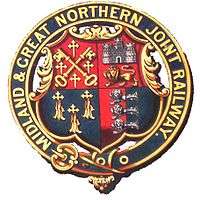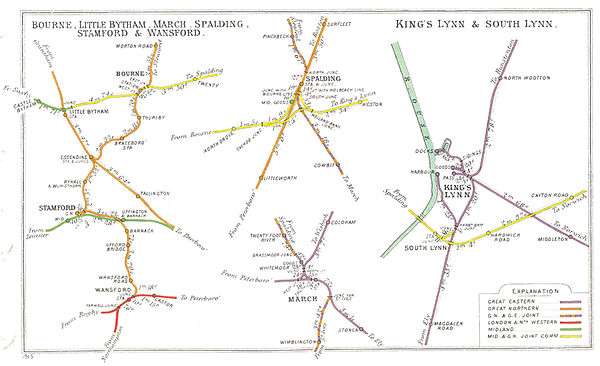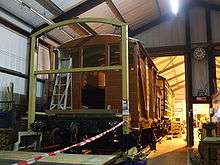Midland and Great Northern Joint Railway
| Midland and Great Northern Joint Railway | |
|---|---|
 | |
| Overview | |
| Type | Regional rail |
| Status | Defunct |
| Locale | East of England |
| Operation | |
| Opened | 1893 |
| Closed | 1959 |
| Technical | |
| Track length | 180 miles (290 km) |
| Track gauge | 4 ft 8 1⁄2 in (1,435 mm) |
The Midland and Great Northern Joint Railway, (M&GN) was a joint railway owned by the Midland Railway (MR) and the Great Northern Railway (GNR) in eastern England, affectionately known as the 'Muddle and Get Nowhere' to generations of passengers, enthusiasts, and other users.
Location
The main line ran from Peterborough to Great Yarmouth via South Lynn and Melton Constable. Branches ran from Sutton Bridge to an end on junction with the Midland Railway branch from Saxby, at Little Bytham near Bourne, Lincolnshire; from Melton Constable to Cromer; and from Melton Constable to Norwich. There was also a short spur connecting South Lynn to King's Lynn and its docks.
History
The Midland & Great Northern Joint Railway was formed in 1893 by the amalgamation of many smaller local lines, rather than being conceived from the start as a single trunk route. However, it offered its two parents – the MR and the GNR – access to the ports of East Anglia, and also enabled them to develop what became a lucrative source of revenue from holiday traffic from the industrial Midlands to the east coast resorts. It was easily the longest joint railway system in the UK, exceeding 180 miles (290 km).
Until the creation of the M&GN, the Great Eastern Railway (GER) held a near-monopoly on East Anglian traffic and had assumed that their network meant there were no population centres left to connect. However, the GER lines were mostly north to south, centred on London, leaving an opening for the smaller companies that later became the M&GN to thread their way east to west between the GER lines, and in this way connected the major towns of Norfolk (Great Yarmouth, Norwich, King's Lynn) and many other smaller centres via the MR and GNR networks to the Midlands and the North. Much of the route was single-track, and the gradient profiles were steep. Despite this, the M&GN was able to put up a spirited competition with the shorter GER route to London from Cromer, although it was never able to equal the GER's excellent timings. However, King's Cross terminus (GNR) was nearer the west end of London, and some passengers preferred to use the M&GN route. The main thrust of M&GN services was to and from the Midlands. The goods traffic was also very heavy, particularly coal inwards, and fruit, vegetables, other agricultural products and fish outwards. The single track (approximately 60% of the route mileage), although operated by the most up-to-date methods (the electric train tablet system) did make the seasonal peak loads difficult to handle – August Bank Holiday weekends were particularly difficult, with waves of special trains from and to the Midlands having to thread their way through the normal traffic of local trains and freights. Typical daily flows during the peak usually exceeded 100 trains.
As well as local traffic, the M&GN created a series of regular long-distance services, linking, e.g., London King's Cross to Cromer, and with regular daily services from Liverpool, Manchester, Nottingham, Leeds, Birmingham and Leicester to South Lynn, Cromer, Norwich and Great Yarmouth.
The M&GN's administrative headquarters was at Austin Street, King's Lynn, but its engineering centre and the heart of the system was at Melton Constable: before the railway arrived this village had a population of just over 100 people. Within a few years it had grown tenfold, with almost all the new arrivals employed by the railway and living in company-built housing, and it acquired the nickname of "the Crewe of North Norfolk".
With Grouping in 1923, the M&GN became jointly owned by the London and North Eastern Railway (LNER) and the London, Midland and Scottish Railway (LMS), but it retained its own identity and operated much as it had before the Grouping.
The M&GN was formally operationally incorporated into the LNER in 1936, although it remained heavily dependent on the LMS to provide the bulk of its longer-distance traffic. Most of Melton Constable Railway Works was closed at this time, as was the Austin Street (King's Lynn) administrative headquarters. The system remained jointly owned by the LNER and LMS.
With the creation of the nationalised British Railways corporation in 1948, the M&GN looked vulnerable. It was one of the first major closures with the bulk of its routes shut in 1959; displaced traffic mostly transferring to the former GER routes. Throughout its years of operation under many different owners, and notwithstanding the high proportion of its route that was single-track, it was an extremely safe system – not a single passenger was killed on the M&GN.
Legal ownership
Formerly the Eastern & Midlands Railway Company, which was incorporated by an Act of Parliament of 18 August 1882, and comprised the Lynn & Fakenham, Yarmouth & North Norfolk (Light), and Yarmouth Union undertakings – these were all dissolved on 31 December 1882. The company also controlled the Cromer Railway.
From 1 July 1893 the properties of the company were acquired by the Midland and Great Northern companies under the provisions of the Midland and Great Northern railway companies (Eastern and Midland Railway) Act 1893, managed by a Joint Committee of the two companies having equal rights.
From 1 January 1923 the Midland Railway became vested in the London Midland & Scottish Railway Company, and the Great Northern Railway in the London & North Eastern Railway Company.
The LMS and LNER jointly managed the line from 1923, with all operations being taken over by the LNER in 1936.
The committee passed to the British Transport Commission (Railway Executive) under Schedule 3 of the Transport Act 1947, which was subsequently replaced by the British Railways Board.
Key people
For over 40 years William Marriott served the M&GN and its predecessors, joining the staff of the original contractors in 1881, serving as Engineer from 1883, Locomotive Superintendent from 1884 and finally becoming Traffic Manager as well in 1919, before retiring in 1924. He is commemorated in the name of the Marriott's Way footpath, much of which follows the trackbed of the M&GN Norwich line, and in the work of the North Norfolk Railway
Junctions

Crossing other railways
In 1894, the M&GN's line between Bourne and Saxby broke through the abandoned trackbed of the Earl of Ancaster's disused Edenham & Little Bytham Railway. At Murrow the M&GN Joint crossed the GN & GE Joint on the level, one of few such crossings in the UK and the only one where two joint lines crossed.
Locomotives
Because of the relatively early closure date, most workings throughout the life of the M&GN were operated by steam power. A small number of diesel multiple unit services were run in the final years, alongside the very occasional incursions of early diesel locomotives.
The M&GN mainly used designs from the MR and GNR, but included in its stock some of the older E&M engines, often much rebuilt. The famous Beyer-Peacock engines survived in this way from the early 1880s to the mid-1930s. The best contemporary designs were acquired by the Joint in the 1893 – 1901 period, but as there were no more modern engines forthcoming, the light 0-6-0s and 4-4-0s provided much of the motive power on the line until 1936. From then on the LNER tried various designs on the line, not necessarily bigger or even more recent than the Joint's own engines, but as the M&GN's engines were scrapped, newer engines such as the K2 2-6-0s and B12 4-6-0s became common. The ex-GER "Claud Hamilton" 4-4-0s provided the locomotive backbone of this later period.
From the 1950s, Ivatt 4MTs became the dominant motive power on the system, which achieved a higher degree of standardisation than any other part of British Railways—more than 50 of these "mucky ducks" were allocated here. But there were other types still in use, and among them the line saw Ivatt 2MTs and occasional Standard 4MT and LNER B1 and B17 types.
British Railways' Eastern Region was an early adopter of diesel motive power and the M&GN lines were used by Brush Type 2 locomotives and several early DMU types including Class 101 and Class 105s. A fleet of the latter was commissioned in the mid-1950s to take over all the long-distance locomotive-hauled passenger services, but the line's closure in 1959 saw them re-allocated (especially to the Great Northern suburban commuter workings out of King's Cross, for which they were particularly unsuitable). One M&GN boiler from a Hudswell Clarke 4-4-0T survives, it is hoped this will be rebuilt as a static exhibit.
Badge and livery
The M&GN device consists of images derived from the Coats of Arms of the four principal cities and towns it served: (clockwise from top left) Peterborough, Norwich, Great Yarmouth and King's Lynn.
For much of the company's life the locomotives were painted a light golden brown, often referred to by paintshop staff as "autumn leaf" or "golden ochre". From 1922 the goods engines were painted dark brown, followed by the rest of the locomotives in 1929. The LNER painted the survivors black. Most of the carriages were ex-GNR and were varnished teak, but some of the older stock and rebuilds were painted and grained to look like teak. Wagon stock was generally brown oxide, the same colour as the GNR used, until 1917 when general stock under the common user agreement began to be painted grey. The number of M&GN wagons declined during the 1920s, and were eventually bought by the parent companies in 1928, leaving only service stock, which was painted red oxide. Under British Railways' control, carriages were often carmine and cream, then maroon.
Cultural impact and heritage

The M&GN was frequently referred to as the "Muddle and Go Nowhere",[1] a fairly self-evident title for a route that served a mostly rural region, but after closure this phrase was commonly replaced with the phrase "Missed and Greatly Needed".[2]
Many of the former routes have disappeared – ploughed back into the fields or reverting to woodland, though some trackbeds survive (especially in the country) along with disused architecture (stations, bridges, signal-boxes etc.).
The M&GN's memory is kept alive by two heritage railway operations and railway museums. Whilst only the short section between Cromer Beach and Sheringham remains open to regular services,[3] the section of branch line between Sheringham and Holt is operated as the North Norfolk Railway.[4] The station at Whitwell also operates as a heritage centre, with ambitions to restore a section of the M&GN main line.[5] There is also a group dedicated to the study of the line.
M&GN signal boxes survive at numerous locations,[6] with Cromer Beach 'box[7] and Sheringham East 'box being open to the public.[8] The 'box from Honing also survives at the Barton House Railway near Wroxham.[9]
The turntable from Bourne engine shed has also survived. This turntable was built in Ipswich in 1933 and installed at Bourne. When the shed closed along with the line in 1959 it was transferred to Peterborough East railway station. After that shed closed the turntable was rebuilt at Wansford station on the Nene Valley railway[10]
Very little rolling stock from the line has been preserved. The North Norfolk Railway have rescued two passenger coaches and a brake van, while a third passenger coach has recently been preserved by the Whitwell & Reepham Railway. No locomotives survived, with the last complete locomotive being scrapped at the Longmoor Military Railway in 1953.[11]
The "golden ochre" livery has been carried by two industrial locomotives on the North Norfolk Railway,[12] and is now worn by a bus frequently operated by Norfolk Green[13] on routes formerly served by the company.
References
- ↑ "Walpole Cross Keys village website". Walpolecrosskeys.co.uk. Retrieved 17 November 2012.
- ↑ "Trip Back to the Golgen Age of Steam." Spalding Advertiser
- ↑ "Bittern Line homepage". Bitternline.com. Retrieved 17 November 2012.
- ↑ "North Norfolk Railway". Nnrailway.co.uk. Retrieved 17 November 2012.
- ↑ http://www.whitwellstation.com/default.asp Whitwell and Reepham Railway Archived 18 July 2011 at the Wayback Machine.
- ↑ "The signal box M&GN listing". Signalbox.org. Retrieved 17 November 2012.
- ↑ "Cromer signalbox museum". Cromerbox.co.uk. Retrieved 17 November 2012.
- ↑ "North Norfolk Railway – Sheringham station facilities". Nnrailway.co.uk. Retrieved 17 November 2012.
- ↑ "Barton House Railway signalling" .bartonhouserailway.org.uk Archived 5 September 2011 at the Wayback Machine.
- ↑ "Nene Valley Railway". Nvr.org.uk. 5 April 1977. Retrieved 17 November 2012.
- ↑ Rowledge, S. "Midland and Great Northern Joint Railway locomotive list". Staplehurst: Robinjay Press.
- ↑ "Photo of Harlaxton in M&GN livery". Arpg.org.uk. 6 December 2004. Retrieved 17 November 2012.
- ↑ "Norfolk Green fleet list" (PDF). Retrieved 17 November 2012.
Further reading
- "The District Controller's View No.12: Midland and Great Northern Joint Railway: M&GN Railway Operating in the 1950s", W.S.Becket (Xpress Publishing) Detailed timetables and descriptions of all line workings, including freight
- "Railway World Special – The M&GN", M.J.Clark (Ian Allan)
- "Scenes from the M&GN", R.H.Clark (Moorland)
- "A Short History of the M&GN Joint Railway", R.H.Clark (Goose & Son)
- "A Guide to the Midland & Great Northern Joint Railway", Nigel Digby (Ian Allan)
- "The Liveries of the M&GN", Nigel Digby (M&GN Circle)
- "M&GN in Colour – vol.1", Dennis Greeno (M&GN Jt Railway Society 2009)
- "Building a Railway: Bourne to Saxby", Stewart Squires & Ken Hollamby (eds) (Lincoln Record Society, 2009) ISBN 978-0-901503-86-2 An extraordinary collection of photographs by resident engineer Charles Stansfield Wilson, taken 1890–93, showing the construction of this extension of the M&GN
- "The Locomotives of the M&GN", A.M.Wells (HMRS) A detailed and definitive work
- "Running a Norfolk Railway", A.C.Whitaker (M&GN Circle)
- "Operation Norfolk: Midland & Great Northern Joint Railway Passenger Services 1954", E.Wilkinson (Xpress Publishing)Detailed timetables and descriptions of passenger workings
- "The M&GN Joint Railway", A.J.Wrottesley (David & Charles) A good, detailed overview of the history of the M&GN
- "British Railways Past and Present – 27 Lincolnshire", Roger Hill & Carey Vessey (Past & Present Publishing 1995) Annotated photographs some of which are of the M&GN
Middleton Press "Encyclopedia of Railways" series, featuring annotated track plans and small photographs:
- "Branch Lines Around Cromer", Richard Adderson and Graham Kenworthy, (Middleton Press 1998)
- "Branch Lines Around Lowestoft", Richard Adderson and Graham Kenworthy, (Middleton Press 2008)
- "Branch Lines Around Spalding – M&GN Saxby to Long Sutton", Michael Back, (Middleton Press 2009)
- "Branch Lines Around Wisbech", Andrew Ingram, (Middleton Press 1997)
- "Melton Constable to Yarmouth Beach", Richard Adderson and Graham Kenworthy, (Middleton Press 2007)
- "Peterborough to King's Lynn: part of the M&GN", Michael Back, (Middleton Press 2008)
- "South Lynn to Norwich City via Melton Constable", Richard Adderson & Graham Kenworthy (Middleton Press 2011)
External links
![]() Media related to Midland and Great Northern Joint Railway at Wikimedia Commons
Media related to Midland and Great Northern Joint Railway at Wikimedia Commons
- The Midland & Great Northern Circle
- Midland & Great Northern Joint Railway Society
- M&GN FAQ
- Cromer Signalbox project